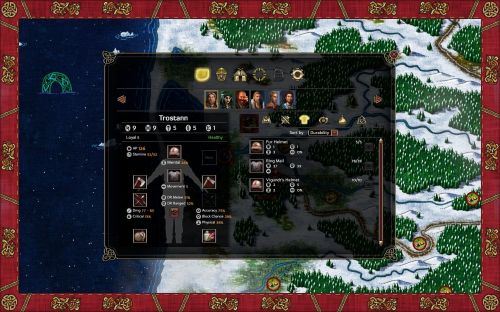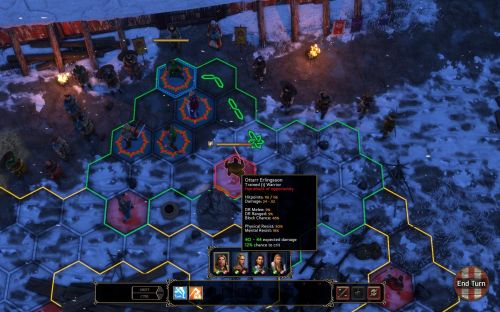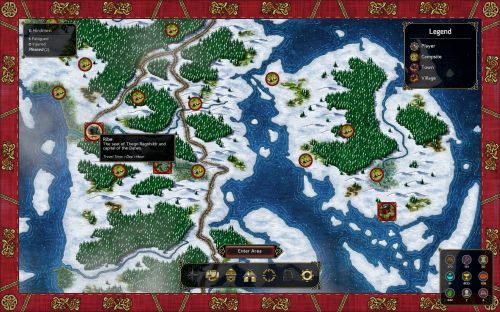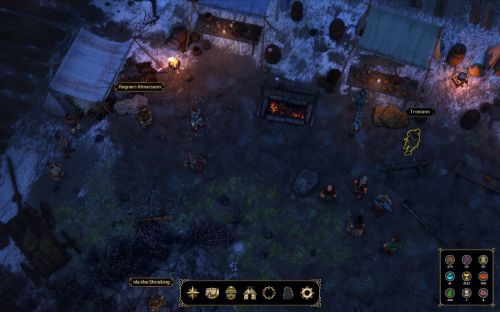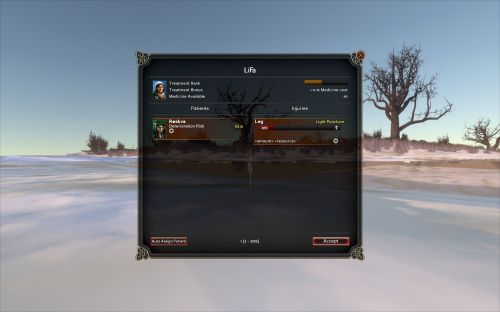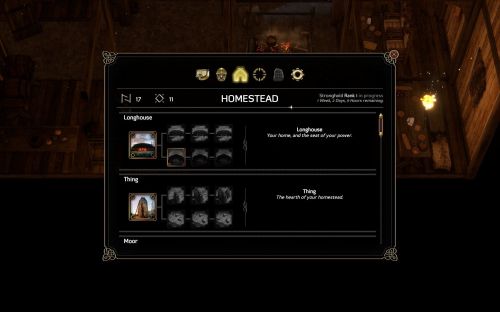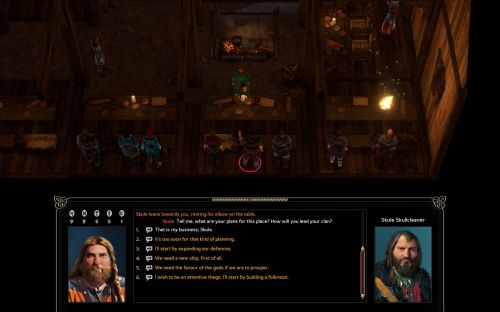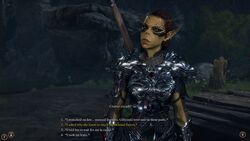RPG Codex Preview: Expeditions: Viking
RPG Codex Preview: Expeditions: Viking
Preview - posted by Infinitron on Wed 14 December 2016, 22:57:36
Tags: Expeditions: Viking; Logic ArtistsTomorrow begins the beta of Expeditions: Viking, sequel to 2013's Expeditions: Conquistador and one of next year's most anticipated indie RPGs. You may have noticed that various websites have been publishing previews of the game over the past few weeks. The RPG Codex was also offered an Expeditions: Viking preview key, but with November's RPG releases looming ahead we weren't sure what to do with it. It was former Codex collaborator Bubbles who felt that it was important that we make use of what we were offered, and one of his final actions was the recruitment of esteemed community member Abu Antar, who is a big fan Expeditions: Conquistador, to write our preview. His impressions? In short, he found Viking to be a bit better than Conquistador in some ways, a bit worse in other ways, but it's really too early to tell. Tomorrow we'll all know more, but for now, have a snippet:
Read the full article: RPG Codex Preview: Expeditions: Viking
Expeditions: Viking begins with a feast. Your father has passed away and you are to become the new chieftain. Some runts come in to interrupt the event, and you have to choose how to deal with the situation. This introduction eases you into the game’s mechanics and demonstrates some of the things you can expect to see throughout the game.
The game begins with a few fairly easy fights to help you get the hang of how combat works. Things get a bit more challenging later on, but I never saw a Game Over screen. Most encounters consist of six or so enemies pitted against five of your chosen soldiers and your main character. You'll have to be careful how you approach a fight in the first few encounters after the tutorial or you will end up with dead team members fairly quickly. Try to bide your time or find cover. Archers are deadly, especially with their aimed shot ability that significantly raises accuracy.
The game's first few fights were the most challenging for me, because I didn't know what to expect. Once I had fought a few battles however, there weren't many fights that gave me any trouble. I can't really say that any of the game's scripted story battles were spectacular, but they were decent enough. You'll have enemies coming at you from different directions, and in some battles you'll start out in the open and have to try to find cover or the enemy archers will whittle down your hit points bit by bit. There was one battle that I particularly liked which I couldn't beat on my first try. Coming back to it later, I realized that I had to be more careful with how I advanced towards the enemy, making proper use of cover.
The battles I didn't enjoy were the ones you fight at campsites when you rest on the world map. Almost all of these battles are identical and they're not very challenging. This was something I had hoped would be improved from the previous game. It's more of a waste of time than a real challenge.
While I did enjoy Conquistador a lot, its combat encounters became repetitive pretty quickly because there weren't many enemy types to deal with and the combat maps were forgettable. Viking improves on this somewhat with its story battles, which are fought directly on the detailed 3D maps that you explore, but I think encounter design could still be improved a bit more.
[...] If a character falls in combat, they become injured but are not permanently gone. (Similarly, you can also lose your entire party without losing the game, although this never actually happened to me.) While camping, you can heal your wounded characters' injuries using medicine. Wounds to different body parts will cause different types of penalties specific to the body part. For example, a groin injury lowers movement range, while arm injuries lower strength. In my game, my character suffered a light puncture wound, and therefore lost two points of Strength before I healed her.
One thing particularly worth noting is that your injuries deteriorate over time. This can cause a wound to go from light all the way up to lethal (there are five stages before you get to the most dangerous phase of an injury). If you go beyond that, your character will incur a permanent stat loss or even risk permanent death. This is basically the only way to lose a character forever. As your wounds go from light to moderate and so on, the deterioration chance increases. In other words, you need to keep a close look at the injuries your characters sustain in order to manage the deterioration. A character can have more than one wounded body part, making it important to choose which injuries are healed and when.
In addition to wounds, your characters also suffer from hunger. Hunger can sated by eating either meat or rations (which can be created from meat with the right set of skills). Meat is more filling than rations, but it deteriorates over time, so proper resource management is key.
The game begins with a few fairly easy fights to help you get the hang of how combat works. Things get a bit more challenging later on, but I never saw a Game Over screen. Most encounters consist of six or so enemies pitted against five of your chosen soldiers and your main character. You'll have to be careful how you approach a fight in the first few encounters after the tutorial or you will end up with dead team members fairly quickly. Try to bide your time or find cover. Archers are deadly, especially with their aimed shot ability that significantly raises accuracy.
The game's first few fights were the most challenging for me, because I didn't know what to expect. Once I had fought a few battles however, there weren't many fights that gave me any trouble. I can't really say that any of the game's scripted story battles were spectacular, but they were decent enough. You'll have enemies coming at you from different directions, and in some battles you'll start out in the open and have to try to find cover or the enemy archers will whittle down your hit points bit by bit. There was one battle that I particularly liked which I couldn't beat on my first try. Coming back to it later, I realized that I had to be more careful with how I advanced towards the enemy, making proper use of cover.
The battles I didn't enjoy were the ones you fight at campsites when you rest on the world map. Almost all of these battles are identical and they're not very challenging. This was something I had hoped would be improved from the previous game. It's more of a waste of time than a real challenge.
While I did enjoy Conquistador a lot, its combat encounters became repetitive pretty quickly because there weren't many enemy types to deal with and the combat maps were forgettable. Viking improves on this somewhat with its story battles, which are fought directly on the detailed 3D maps that you explore, but I think encounter design could still be improved a bit more.
[...] If a character falls in combat, they become injured but are not permanently gone. (Similarly, you can also lose your entire party without losing the game, although this never actually happened to me.) While camping, you can heal your wounded characters' injuries using medicine. Wounds to different body parts will cause different types of penalties specific to the body part. For example, a groin injury lowers movement range, while arm injuries lower strength. In my game, my character suffered a light puncture wound, and therefore lost two points of Strength before I healed her.
One thing particularly worth noting is that your injuries deteriorate over time. This can cause a wound to go from light all the way up to lethal (there are five stages before you get to the most dangerous phase of an injury). If you go beyond that, your character will incur a permanent stat loss or even risk permanent death. This is basically the only way to lose a character forever. As your wounds go from light to moderate and so on, the deterioration chance increases. In other words, you need to keep a close look at the injuries your characters sustain in order to manage the deterioration. A character can have more than one wounded body part, making it important to choose which injuries are healed and when.
In addition to wounds, your characters also suffer from hunger. Hunger can sated by eating either meat or rations (which can be created from meat with the right set of skills). Meat is more filling than rations, but it deteriorates over time, so proper resource management is key.
Read the full article: RPG Codex Preview: Expeditions: Viking
[Preview by Abu Antar]
Preview: Expeditions: Viking
In August 2012, the Kickstarter campaign for Expeditions: Conquistador was launched by Danish studio Logic Artists, a studio unknown to me at the time. I discovered the project and followed the campaign, but never actually backed it, as I was hesitant to give money to something that sounded good but might not turn into a good end product. Closer to launch, I read some impressions of this turn-based, tactical RPG with CYOA and survival elements, and decided to take a gamble. The game turned out to be a huge surprise for me. Not only was its gameplay great but so was the writing, with an interesting setting in Mexico and Hispaniola during the Age of Discovery. Naturally, when I saw that the Codex was trying to find someone to preview its sequel, Expeditions: Viking, I immediately pounced on the opportunity.
Character Creation and Progression
As soon as you start the game and choose to go on a new adventure, you are invited to customize your Viking chieftain. You get to choose your sex, portrait, skin color, hair, and all the other usual cosmetic choices. If you don't want to bother with that stuff, you have the option to randomly generate how your chieftain will look. Once you're done with that, you get to the customization that really matters. There are five primary stats, Strength, Endurance, Finesse, Perception, and Sense, which determine your secondary stats, which include hit points, stamina and critical chance, to name a few. For example, Finesse will improve your base damage with spears and knives, as well as increase the likelihood of critical hits. Based on how you decide to spread out your points, there will be a small description box that summarizes your character’s abilities and reflects your stat choices. You start out with 5 points in each primary stat, but it's possible to lower your stats to 1 to get more points to spend.
Once your stats are set, you move on to choose your skills. There are five categories of skills you can focus in, Weapons, Offensive, Support, Utility and Passive, with 67 skills altogether. (Note that some of them were unavailable in this preview version.) Some skills can be picked only once, while others can be upgraded up to five times. Some can only be chosen if your primary stats are high enough. For example, the skills in the Sense section were unavailable to me because I didn't put any points in Sense or Perception. Spending points on combat skills will unlock moves. For instance, spend enough points in Axes and you will gain the Shield Hook ability which pulls the opponent's shield away, leaving them with the exposed status. Or you can upgrade your proficiency with a bow and learn Quick Shots and Aimed Shots. The difference between Viking and its predecessor is that in Conquistador you were locked in to a certain role. Here, there are no real classes, and you can pick and choose skills to make hybrid characters to your liking. Of course, you can still go with a standard tank or ranger build if that's what you want. There are nine available preset character builds to choose from, all with varying combat and non-combat roles. These are basically templates that can help you at the beginning of the campaign, but they're not at all required.
For the purposes of this preview, I decided to go with a ”strong and tough man, but slow of wit” type of character, as the description text read.
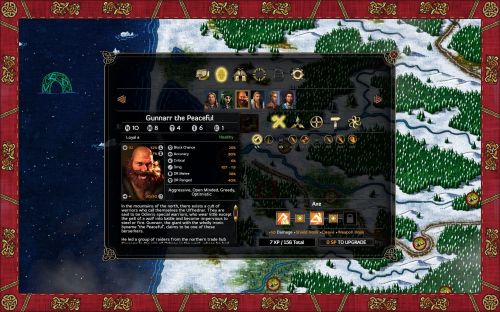
Does that character portrait scream peaceful? At least he has an open-minded and optimistic personality.
Completing tasks or quests earns you skills points that you can then spend to further develop your character as you progress. Although not all skills are available in this early version of the game, I still felt that I could construct a decent variety of builds. My party had a spear wielding warrior that stuck close to my sword and board fighter, a healing witch that stayed close to my archer, and two dual wielding berserkers that could advance quickly towards the enemy. At first glance, the melee characters might seem all too similar, but tactics can change depending on each character’s choice of weapons. My spear wielder was great to have as backup because he could reach across two cells, while the dual wielding guys and the shield bearer could only reach one. Equipping a shield can save you thanks to the block chance they provide and they can also absorb damage. Your long range characters will most likely be very squishy, and keeping them back is a good strategy to keep them safe. Swords have a low critical chance, but higher regular damage than axes, while axes are weaker than swords but are more likely to critically hit the enemy. If you choose to, you can set up characters with two weapon sets. I had most of my characters set up with one melee weapon and one ranged weapon.
Further choices can be made with armor. Heavier armor usually means more damage reduction at the cost of less movement range. There are also talismans and other superstitious ornaments one can wear, but I didn't find any in this demo build. Last but not least, you can also equip two consumable items. These include healing potions, items that give different buffs, caltrops or other devices that halt an enemy’s effectiveness, and torches that help you hit adjacent targets when it's dark. Equipment that you don't want can either be sold or turned into salvage. I didn't find much in the way of unique items, finding maybe one or two during my playthrough.
Party Composition
My companions in my Expeditions: Viking playthrough were mainly fellow Vikings who knew my chieftain before the game’s events, and another who was a raider who attacked my village at the beginning of the game and agreed to join. In addition to the companions, there was a quest later on in the game that allowed me to hire mercenaries for my Viking hird. The preview build offers four premade mercenaries to recruit, with no option to customize their skills or abilities, but in the final game you will be able to customize them as you see fit. Personally, I hope we don't end up with just generic Vikings as companions. I'd be interested in seeing more unlikely followers join your group. That was the case in Conquistador, where the different personality traits of each companion mattered and could directly influence whether another follower left your party or if a mutiny happened. Personality traits are still present in Viking: Honorable, Greedy, Independent, Pessimistic, Open-Minded and so on. However, I wasn’t able to tell how much of a role they will have in the final game from the preview build. I did have companions object to my actions occasionally, but I never feared losing them. I didn't have much of a problem keeping everyone happy. One companion was indifferent, but otherwise it was pretty simple to keep everyone pleased.
In addition to their happiness, you will also have to think about your characters' fatigue and injuries, but more on that later.
Expeditions: Conquistador was known for its CYOA sequences, where you interacted with your crew and faced difficult choices that could have unforeseen consequences. These choices were directly influenced by the personality traits of your crew members. I did not encounter any of these in Viking. I asked the developers about that, and they confirmed that CYOA sequences will be included in the final game, but there would probably be less of them, which is a shame as they were one of my favorite parts of the first game.
Let the game begin
Expeditions: Viking begins with a feast. Your father has passed away and you are to become the new chieftain. Some runts come in to interrupt the event, and you have to choose how to deal with the situation. This introduction eases you into the game’s mechanics and demonstrates some of the things you can expect to see throughout the game.
The game begins with a few fairly easy fights to help you get the hang of how combat works. Things get a bit more challenging later on, but I never saw a Game Over screen. Most encounters consist of six or so enemies pitted against five of your chosen soldiers and your main character. You'll have to be careful how you approach a fight in the first few encounters after the tutorial or you will end up with dead team members fairly quickly. Try to bide your time or find cover. Archers are deadly, especially with their aimed shot ability that significantly raises accuracy.
The game's first few fights were the most challenging for me, because I didn't know what to expect. Once I had fought a few battles however, there weren't many fights that gave me any trouble. I can't really say that any of the game's scripted story battles were spectacular, but they were decent enough. You'll have enemies coming at you from different directions, and in some battles you'll start out in the open and have to try to find cover or the enemy archers will whittle down your hit points bit by bit. There was one battle that I particularly liked which I couldn't beat on my first try. Coming back to it later, I realized that I had to be more careful with how I advanced towards the enemy, making proper use of cover.
The battles I didn't enjoy were the ones you fight at campsites when you rest on the world map. Almost all of these battles are identical and they're not very challenging. This was something I had hoped would be improved from the previous game. It's more of a waste of time than a real challenge.
While I did enjoy Conquistador a lot, its combat encounters became repetitive pretty quickly because there weren't many enemy types to deal with and the combat maps were forgettable. Viking improves on this somewhat with its story battles, which are fought directly on the detailed 3D maps that you explore, but I think encounter design could still be improved a bit more.
World travel and battle maps
Time passes as you travel from one location to another on the world map, be it a town, wilderness area or campsite. Your characters' stamina determines how many hours they can travel before they become fatigued. The world map is 2D. You no longer explore it like you did in the first game, where the 3D map you traveled on was the actual game world. Instead, you click on locations on the map and explore them in 3D. The 3D view is isometric, which works fine for seeing the battlefield and executing your moves. You can rotate the camera 360 degrees and zoom in and out.
Once you arrive at a location and assume control over your characters, you're free to explore the area. You'll find NPCs, traders, quests and lootable containers. You can enter buildings that are relevant to the game's story or side quests. The containers you can loot mostly contain resources that you'll need, but sometimes you'll find weapons and armor as well. Some containers are free to loot, but others demand that you have a high enough finesse or people will notice and become upset with you. Steal too much and you will eventually be attacked. There was a funny bug where I killed everyone in a house and looted a container and a corpse became upset with me and said it would kill me.
You'll inevitably get into fights as you explore, both in wilderness areas and in towns. Enemies drop loot which you can pick up, in some cases equipment, but usually various resources. Some locations, mostly wilderness areas, have herbs that you can pick. While exploring, your companions will occasionally banter with one another, and sometimes if you stop certain NPCs will chat with each other.
As I mentioned previously, while travelling on the world map you can rest at campsites. As in Conquistador, you have the ability to assign various camping tasks to your party members. You can choose between guarding, hunting, cooking, and so on. Each provides its own specific benefit. While camping, you also decide how you will ration out meat and rations to your characters. One thing that’s different from Conquistador is that in Viking each character has four shifts while your party camps. You need to set up these shifts in a way that maximizes the resting time of each party member. Just make sure to let each party member rest for at least two shifts. Alternatively, you can learn a skill that allows characters to become well-rested by resting for only one shift.
Survival Aspects
If a character falls in combat, they become injured but are not permanently gone. (Similarly, you can also lose your entire party without losing the game, although this never actually happened to me.) While camping, you can heal your wounded characters' injuries using medicine. Wounds to different body parts will cause different types of penalties specific to the body part. For example, a groin injury lowers movement range, while arm injuries lower strength. In my game, my character suffered a light puncture wound, and therefore lost two points of Strength before I healed her.
One thing particularly worth noting is that your injuries deteriorate over time. This can cause a wound to go from light all the way up to lethal (there are five stages before you get to the most dangerous phase of an injury). If you go beyond that, your character will incur a permanent stat loss or even risk permanent death. This is basically the only way to lose a character forever. As your wounds go from light to moderate and so on, the deterioration chance increases. In other words, you need to keep a close look at the injuries your characters sustain in order to manage the deterioration. A character can have more than one wounded body part, making it important to choose which injuries are healed and when.
In addition to wounds, your characters also suffer from hunger. Hunger can sated by eating either meat or rations (which can be created from meat with the right set of skills). Meat is more filling than rations, but it deteriorates over time, so proper resource management is key.
As chieftain of your Viking clan, you're required to manage your village. The village requires various resources, such as slaves who make your homestead upgrades go faster, wood for upgrading your buildings, valuables to buy equipment and other items, salvage for crafting weapons and armor, and so on. You can upgrade facilities such as your thing, blacksmith, moor, and more. These upgrades will boost your Prosperity or Power, but can also provide other types of bonuses. You can get a new trader to come into town. Or why not get a weekly income of 50 valuables? Maybe you want 4 rations and 2 prosperity added every week? I didn't delve much into this system, but I believe it will become more important in the final game, where you'll be able to use your boat to travel farther afield from the village. Unfortunately, the preview build ends before this aspect of the game has a chance to feel relevant.
Writing
What really interested me in Expeditions: Viking was what surprised me the most about Expeditions: Conquistador - its writing. Does it live up to its predecessor in that area? In my opinion, not quite. But it's still a bit early to tell, as the preview ends right when things start to get interesting. The game's writing is solid, but I feel like its quests didn't really do the writing justice. None of the quests were very complex (though again, keep in mind that I only got to play the beginning of the game). I will give the game credit for offering different dialog options that make use of your stats, as well as having different ways to solve quests. In my playthrough, I mostly killed anything and everything in my sight, with a few sprinkles of helping people out, and the game let me do that.
Final Thoughts
My overall impression of Expeditions: Viking's preview is positive. The writing is solid, but needs to be supported by slightly more interesting quests. I think one reason why I would rate Conquistador a bit higher in this area is that I never got to see any CYOA sequences. As stated, the developers have confirmed they'll be in for the final game.
Another thing that I preferred in the first game is the exploration. It just doesn't feel the same now that they've tossed away the 3D world map for a 2D map with the locations being separate instances.
The game's combat mechanics are solid and the story battles are fun, though I suspect that the feeling of repetition will eventually set in just like it did in the first game. I like the character progression system, even though many skills and abilities were unavailable in this version. It seems to me that Viking is going to have a little bit more in the way of character customization than its predecessor. I also like that you gain skill points for finishing quests.
I can't really offer any further thoughts about the village upgrade system, but I do know that it will play a more important role as you progress further into the game.
I encountered many technical issues and bugs during my playthrough. My characters would become invisible or unable to move. NPCs would become invisible as well. I had a couple of freezes. Unintentionally sequence breaking a particular quest broke it, making it impossible to complete. Another quest I completed and was then offered it again. I'm not too worried about this though, as the preview build appears to be an alpha version. I had no problems with the first game when I played it, and I expect all of these issues to be ironed out for the final release.
Preview: Expeditions: Viking
In August 2012, the Kickstarter campaign for Expeditions: Conquistador was launched by Danish studio Logic Artists, a studio unknown to me at the time. I discovered the project and followed the campaign, but never actually backed it, as I was hesitant to give money to something that sounded good but might not turn into a good end product. Closer to launch, I read some impressions of this turn-based, tactical RPG with CYOA and survival elements, and decided to take a gamble. The game turned out to be a huge surprise for me. Not only was its gameplay great but so was the writing, with an interesting setting in Mexico and Hispaniola during the Age of Discovery. Naturally, when I saw that the Codex was trying to find someone to preview its sequel, Expeditions: Viking, I immediately pounced on the opportunity.
Character Creation and Progression
As soon as you start the game and choose to go on a new adventure, you are invited to customize your Viking chieftain. You get to choose your sex, portrait, skin color, hair, and all the other usual cosmetic choices. If you don't want to bother with that stuff, you have the option to randomly generate how your chieftain will look. Once you're done with that, you get to the customization that really matters. There are five primary stats, Strength, Endurance, Finesse, Perception, and Sense, which determine your secondary stats, which include hit points, stamina and critical chance, to name a few. For example, Finesse will improve your base damage with spears and knives, as well as increase the likelihood of critical hits. Based on how you decide to spread out your points, there will be a small description box that summarizes your character’s abilities and reflects your stat choices. You start out with 5 points in each primary stat, but it's possible to lower your stats to 1 to get more points to spend.
Once your stats are set, you move on to choose your skills. There are five categories of skills you can focus in, Weapons, Offensive, Support, Utility and Passive, with 67 skills altogether. (Note that some of them were unavailable in this preview version.) Some skills can be picked only once, while others can be upgraded up to five times. Some can only be chosen if your primary stats are high enough. For example, the skills in the Sense section were unavailable to me because I didn't put any points in Sense or Perception. Spending points on combat skills will unlock moves. For instance, spend enough points in Axes and you will gain the Shield Hook ability which pulls the opponent's shield away, leaving them with the exposed status. Or you can upgrade your proficiency with a bow and learn Quick Shots and Aimed Shots. The difference between Viking and its predecessor is that in Conquistador you were locked in to a certain role. Here, there are no real classes, and you can pick and choose skills to make hybrid characters to your liking. Of course, you can still go with a standard tank or ranger build if that's what you want. There are nine available preset character builds to choose from, all with varying combat and non-combat roles. These are basically templates that can help you at the beginning of the campaign, but they're not at all required.
For the purposes of this preview, I decided to go with a ”strong and tough man, but slow of wit” type of character, as the description text read.

Does that character portrait scream peaceful? At least he has an open-minded and optimistic personality.
Further choices can be made with armor. Heavier armor usually means more damage reduction at the cost of less movement range. There are also talismans and other superstitious ornaments one can wear, but I didn't find any in this demo build. Last but not least, you can also equip two consumable items. These include healing potions, items that give different buffs, caltrops or other devices that halt an enemy’s effectiveness, and torches that help you hit adjacent targets when it's dark. Equipment that you don't want can either be sold or turned into salvage. I didn't find much in the way of unique items, finding maybe one or two during my playthrough.
Party Composition
My companions in my Expeditions: Viking playthrough were mainly fellow Vikings who knew my chieftain before the game’s events, and another who was a raider who attacked my village at the beginning of the game and agreed to join. In addition to the companions, there was a quest later on in the game that allowed me to hire mercenaries for my Viking hird. The preview build offers four premade mercenaries to recruit, with no option to customize their skills or abilities, but in the final game you will be able to customize them as you see fit. Personally, I hope we don't end up with just generic Vikings as companions. I'd be interested in seeing more unlikely followers join your group. That was the case in Conquistador, where the different personality traits of each companion mattered and could directly influence whether another follower left your party or if a mutiny happened. Personality traits are still present in Viking: Honorable, Greedy, Independent, Pessimistic, Open-Minded and so on. However, I wasn’t able to tell how much of a role they will have in the final game from the preview build. I did have companions object to my actions occasionally, but I never feared losing them. I didn't have much of a problem keeping everyone happy. One companion was indifferent, but otherwise it was pretty simple to keep everyone pleased.
In addition to their happiness, you will also have to think about your characters' fatigue and injuries, but more on that later.
Expeditions: Conquistador was known for its CYOA sequences, where you interacted with your crew and faced difficult choices that could have unforeseen consequences. These choices were directly influenced by the personality traits of your crew members. I did not encounter any of these in Viking. I asked the developers about that, and they confirmed that CYOA sequences will be included in the final game, but there would probably be less of them, which is a shame as they were one of my favorite parts of the first game.
Let the game begin
Expeditions: Viking begins with a feast. Your father has passed away and you are to become the new chieftain. Some runts come in to interrupt the event, and you have to choose how to deal with the situation. This introduction eases you into the game’s mechanics and demonstrates some of the things you can expect to see throughout the game.
The game begins with a few fairly easy fights to help you get the hang of how combat works. Things get a bit more challenging later on, but I never saw a Game Over screen. Most encounters consist of six or so enemies pitted against five of your chosen soldiers and your main character. You'll have to be careful how you approach a fight in the first few encounters after the tutorial or you will end up with dead team members fairly quickly. Try to bide your time or find cover. Archers are deadly, especially with their aimed shot ability that significantly raises accuracy.
The game's first few fights were the most challenging for me, because I didn't know what to expect. Once I had fought a few battles however, there weren't many fights that gave me any trouble. I can't really say that any of the game's scripted story battles were spectacular, but they were decent enough. You'll have enemies coming at you from different directions, and in some battles you'll start out in the open and have to try to find cover or the enemy archers will whittle down your hit points bit by bit. There was one battle that I particularly liked which I couldn't beat on my first try. Coming back to it later, I realized that I had to be more careful with how I advanced towards the enemy, making proper use of cover.
The battles I didn't enjoy were the ones you fight at campsites when you rest on the world map. Almost all of these battles are identical and they're not very challenging. This was something I had hoped would be improved from the previous game. It's more of a waste of time than a real challenge.
While I did enjoy Conquistador a lot, its combat encounters became repetitive pretty quickly because there weren't many enemy types to deal with and the combat maps were forgettable. Viking improves on this somewhat with its story battles, which are fought directly on the detailed 3D maps that you explore, but I think encounter design could still be improved a bit more.
World travel and battle maps
Time passes as you travel from one location to another on the world map, be it a town, wilderness area or campsite. Your characters' stamina determines how many hours they can travel before they become fatigued. The world map is 2D. You no longer explore it like you did in the first game, where the 3D map you traveled on was the actual game world. Instead, you click on locations on the map and explore them in 3D. The 3D view is isometric, which works fine for seeing the battlefield and executing your moves. You can rotate the camera 360 degrees and zoom in and out.
Once you arrive at a location and assume control over your characters, you're free to explore the area. You'll find NPCs, traders, quests and lootable containers. You can enter buildings that are relevant to the game's story or side quests. The containers you can loot mostly contain resources that you'll need, but sometimes you'll find weapons and armor as well. Some containers are free to loot, but others demand that you have a high enough finesse or people will notice and become upset with you. Steal too much and you will eventually be attacked. There was a funny bug where I killed everyone in a house and looted a container and a corpse became upset with me and said it would kill me.
You'll inevitably get into fights as you explore, both in wilderness areas and in towns. Enemies drop loot which you can pick up, in some cases equipment, but usually various resources. Some locations, mostly wilderness areas, have herbs that you can pick. While exploring, your companions will occasionally banter with one another, and sometimes if you stop certain NPCs will chat with each other.
As I mentioned previously, while travelling on the world map you can rest at campsites. As in Conquistador, you have the ability to assign various camping tasks to your party members. You can choose between guarding, hunting, cooking, and so on. Each provides its own specific benefit. While camping, you also decide how you will ration out meat and rations to your characters. One thing that’s different from Conquistador is that in Viking each character has four shifts while your party camps. You need to set up these shifts in a way that maximizes the resting time of each party member. Just make sure to let each party member rest for at least two shifts. Alternatively, you can learn a skill that allows characters to become well-rested by resting for only one shift.
Survival Aspects
If a character falls in combat, they become injured but are not permanently gone. (Similarly, you can also lose your entire party without losing the game, although this never actually happened to me.) While camping, you can heal your wounded characters' injuries using medicine. Wounds to different body parts will cause different types of penalties specific to the body part. For example, a groin injury lowers movement range, while arm injuries lower strength. In my game, my character suffered a light puncture wound, and therefore lost two points of Strength before I healed her.
One thing particularly worth noting is that your injuries deteriorate over time. This can cause a wound to go from light all the way up to lethal (there are five stages before you get to the most dangerous phase of an injury). If you go beyond that, your character will incur a permanent stat loss or even risk permanent death. This is basically the only way to lose a character forever. As your wounds go from light to moderate and so on, the deterioration chance increases. In other words, you need to keep a close look at the injuries your characters sustain in order to manage the deterioration. A character can have more than one wounded body part, making it important to choose which injuries are healed and when.
In addition to wounds, your characters also suffer from hunger. Hunger can sated by eating either meat or rations (which can be created from meat with the right set of skills). Meat is more filling than rations, but it deteriorates over time, so proper resource management is key.
As chieftain of your Viking clan, you're required to manage your village. The village requires various resources, such as slaves who make your homestead upgrades go faster, wood for upgrading your buildings, valuables to buy equipment and other items, salvage for crafting weapons and armor, and so on. You can upgrade facilities such as your thing, blacksmith, moor, and more. These upgrades will boost your Prosperity or Power, but can also provide other types of bonuses. You can get a new trader to come into town. Or why not get a weekly income of 50 valuables? Maybe you want 4 rations and 2 prosperity added every week? I didn't delve much into this system, but I believe it will become more important in the final game, where you'll be able to use your boat to travel farther afield from the village. Unfortunately, the preview build ends before this aspect of the game has a chance to feel relevant.
Writing
What really interested me in Expeditions: Viking was what surprised me the most about Expeditions: Conquistador - its writing. Does it live up to its predecessor in that area? In my opinion, not quite. But it's still a bit early to tell, as the preview ends right when things start to get interesting. The game's writing is solid, but I feel like its quests didn't really do the writing justice. None of the quests were very complex (though again, keep in mind that I only got to play the beginning of the game). I will give the game credit for offering different dialog options that make use of your stats, as well as having different ways to solve quests. In my playthrough, I mostly killed anything and everything in my sight, with a few sprinkles of helping people out, and the game let me do that.
Final Thoughts
My overall impression of Expeditions: Viking's preview is positive. The writing is solid, but needs to be supported by slightly more interesting quests. I think one reason why I would rate Conquistador a bit higher in this area is that I never got to see any CYOA sequences. As stated, the developers have confirmed they'll be in for the final game.
Another thing that I preferred in the first game is the exploration. It just doesn't feel the same now that they've tossed away the 3D world map for a 2D map with the locations being separate instances.
The game's combat mechanics are solid and the story battles are fun, though I suspect that the feeling of repetition will eventually set in just like it did in the first game. I like the character progression system, even though many skills and abilities were unavailable in this version. It seems to me that Viking is going to have a little bit more in the way of character customization than its predecessor. I also like that you gain skill points for finishing quests.
I can't really offer any further thoughts about the village upgrade system, but I do know that it will play a more important role as you progress further into the game.
I encountered many technical issues and bugs during my playthrough. My characters would become invisible or unable to move. NPCs would become invisible as well. I had a couple of freezes. Unintentionally sequence breaking a particular quest broke it, making it impossible to complete. Another quest I completed and was then offered it again. I'm not too worried about this though, as the preview build appears to be an alpha version. I had no problems with the first game when I played it, and I expect all of these issues to be ironed out for the final release.
There are 51 comments on RPG Codex Preview: Expeditions: Viking






